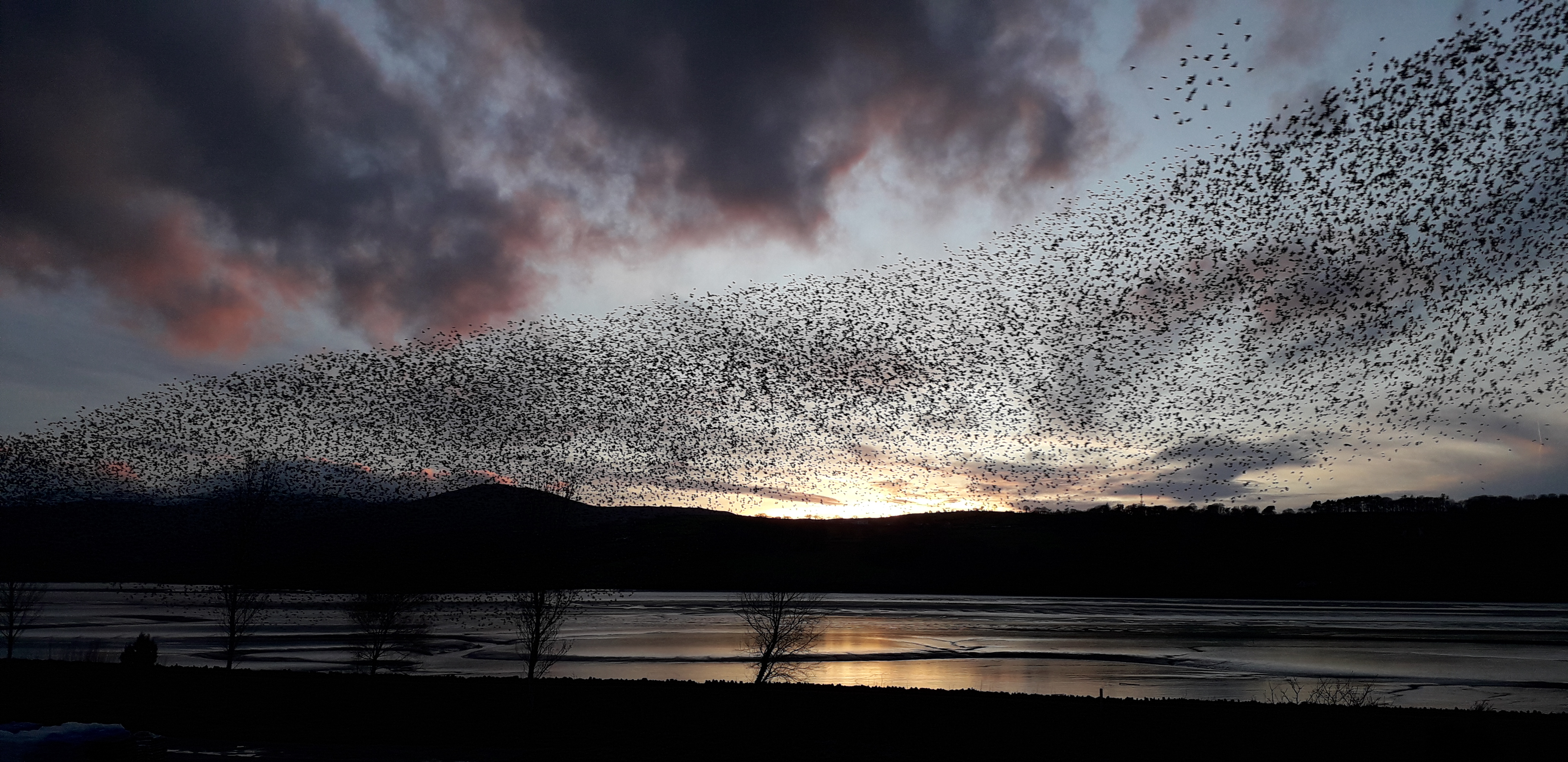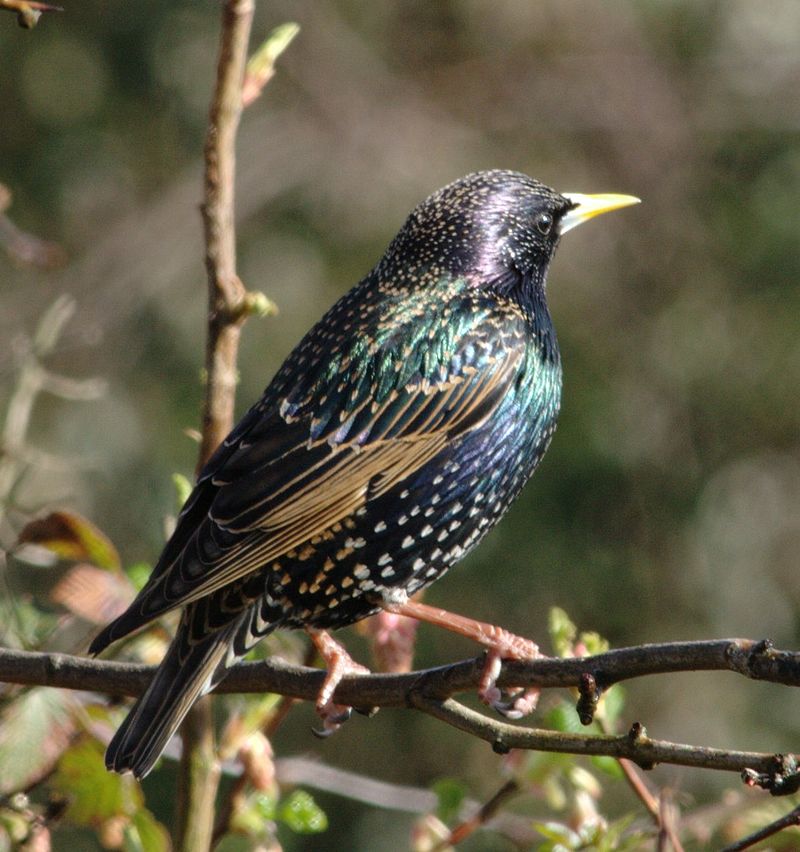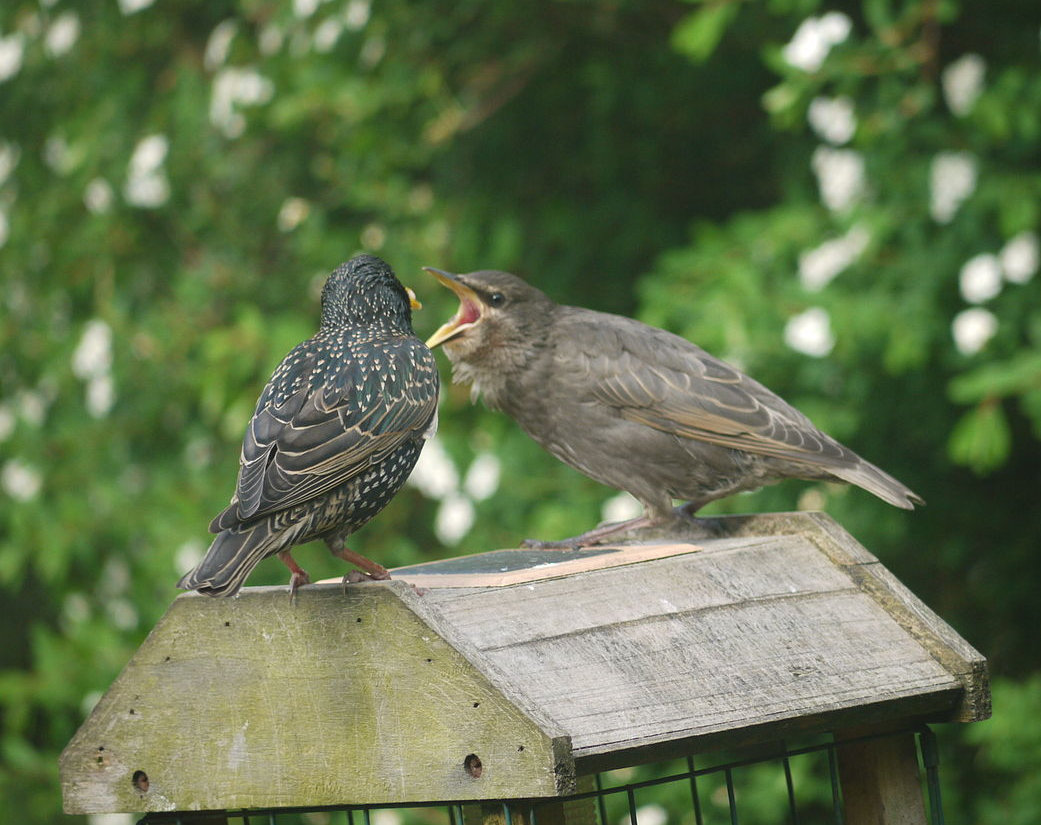Garden Wildlife
Garden Wildlife


What do they eat?
The bill size and shape indicates the starling eats predominantly insects, although it will take any scraps or other food left out at feeding stations. The ‘natural’ feeding of starlings is interesting to watch: they use their robust bills to part grass and leaves on the ground to reveal burrows and soil beneath then plunge their bills in to capture their prey. They are fond of leatherjackets living in the grass roots for example.
Where do they breed?
Starlings breed in holes in trees and the like, and used to make use of holes within the structures of buildings, but these are now much less common with better insulartion. They will happily adopt nest boxes with entrance hole 45mm diameter. The birds breeds from April to June, usually one but sometimes two broods in a good year.
What do they do?
They are basically social birds, forming flocks of various sizes whilst feeding and roosting. Watching a line of starlings moving methodically across a patch of grass, bills probing all the time, indicates a high degree of intelligence and cooperation. In autumn and winter they sometimes form enormous flocks of thousands of birds. Their aerial manoeuvres as they settle to roost are a spectacular sight called a ‘murmuration’ because of the continuous low-key sounds made as they settle, sometimes making extraordinary patterns before plunging down to their communal roost.
Starling Sturnus vulgaris
When a flock of Starlings comes to your feeding station you know it, especially if they have newly fledged young with them. They are relatively abundant (the thirteenth most often recorded in gardens), and very garrulous birds so they are not universally popular.
Murmuration of starlings over the Conwy Estuary - Photo by our Patron Chris Baines
Roosting can take place away from people, for example in reedbeds, but many Starlings roost around human habitations. In the 1980’s the air above centre of Birmingham was filled with thousand upon thousands of Starlings, preparing to roost on the Victorian buildings with their many nooks and crannies – a sight now consigned to history, to the relief of commuters who had to stand below these busy ledges while waiting for buses. Suburban gardens may include trees and hedges that attract smaller roosts of starlings – you can easily identify these by the murmuration sound.
British and Irish birds tend to stay put, but they are supplemented by many thousands of migratory visitors from NW Europe during the winter.
How are they doing?
Although still numerous, starlings in Britain have shown a significant decline. The most recent full Breeding Birds Survey by the BTO (2019) suggests around 50% decline over 20 years, and the bird is Red Listed, as being of conservation concern. There are estimated to be 1.8 million pairs in the UK. Reasons for the decline are not altogether clear, but reduced insect prey for feeding juveniles may have something to do with it. How many garden lawns have disappeared in your neighbourhood over the last 20 years? How many meadows built on?
Finding out more:
RSPB profile on starlings
BTO profile on starlings
Page written by Roy Smith, compiled by Steve Head



What do they look like?
Starlings are pretty distinctive bird as an adult, in build, colouration and habits. They are smaller (22cm) than blackbirds but much bigger than house sparrows, with a lively, upright posture. The black bill is as long as the head and pointed. The head is a bit large for the body compared with many birds in the garden. Their dark red legs are quite long for their body size and they tend to walk about on the ground rather than hopping. The whole body is glossy iridescent black, with close-spaced small pale dots all over. The wing feather edges are browner.
When the plumage is fresh starlings are very smart birds. Males and females are alike while juvenile birds are lighter grey-brown, with a bit of a dark mask around the eyes. As the summer goes on you can easily see the gradual appearance of adult plumage on the juveniles as patches of feathers moult.
What do they sound like?
Starlings are raucous in flocks, making a tremendous noise. Individual adults sing from prominent perches whilst breeding, and they are extremely good mimics. They can sound just like car alarms, telephones, motorbikes or whatever common repeated sound they hear nearby. They have a jumbled, musical, mimicry-filled song that can go on for a long time. Even though they all have their own song, there is distinctive sound to them which makes it obvious you are hearing a Starling. There is a falling whistling note which gives it away. Adults also have a less melodious set of raucous calls when they are flying and interacting.
Song Raucous calls
Irish Wildlife Sounds, XC647792. Accessible at www.xeno-canto.org/647792.
Irish Wildlife Sounds, XC621414. Accessible at www.xeno-canto.org/621414.
The juvenile has a distinctive begging call which must drive the adults mad as they try to cram ever more food into their mouth. When starlings gather to roost they are often hundreds or thousands strong. In the autumn dusk you can hear great murmurings from their roost-sites.
Juveniles begging Roosting noises
Marie-Lan Taÿ Pamart, XC644058. Accessible at www.xeno-canto.org/644058.
Edward Mayer, XC597336. Accessible at www.xeno-canto.org/597336.
Starling Sturnus vulgaris
When a flock of Starlings comes to your feeding station you know it, especially if they have newly fledged young with them. They are relatively abundant (the thirteenth most often recorded in gardens), and very garrulous birds so they are not universally popular.


What do they look like?
Starlings are pretty distinctive bird as an adult, in build, colouration and habits. They are smaller (22cm) than blackbirds but much bigger than house sparrows, with a lively, upright posture. The black bill is as long as the head and pointed. The head is a bit large for the body compared with many birds in the garden. Their dark red legs are quite long for their body size and they tend to walk about on the ground rather than hopping. The whole body is glossy iridescent black, with close-spaced small pale dots all over. The wing feather edges are browner.
When the plumage is fresh starlings are very smart birds. Males and females are alike while juvenile birds are lighter grey-brown, with a bit of a dark mask around the eyes. As the summer goes on you can easily see the gradual appearance of adult plumage on the juveniles as patches of feathers moult.
What do they sound like?
Starlings are raucous in flocks, making a tremendous noise. Individual adults sing from prominent perches whilst breeding, and they are extremely good mimics. They can sound just like car alarms, telephones, motorbikes or whatever common repeated sound they hear nearby. They have a jumbled, musical, mimicry-filled song that can go on for a long time. Even though they all have their own song, there is distinctive sound to them which makes it obvious you are hearing a Starling. There is a falling whistling note which gives it away. Adults also have a less melodious set of raucous calls when they are flying and interacting.
Song Raucous calls
The juvenile has a distinctive begging call which must drive the adults mad as they try to cram ever more food into their mouth. When starlings gather to roost they are often hundreds or thousands strong. In the autumn dusk you can hear great murmurings from their roost-sites.
Juveniles begging Roosting noises
What do they eat?
The bill size and shape indicates the starling eats predominantly insects, although it will take any scraps or other food left out at feeding stations. The ‘natural’ feeding of starlings is interesting to watch: they use their robust bills to part grass and leaves on the ground to reveal burrows and soil beneath then plunge their bills in to capture their prey. They are fond of leatherjackets living in the grass roots for example.
Where do they breed?
Starlings breed in holes in trees and the like, and used to make use of holes within the structures of buildings, but these are now much less common with better insulartion. They will happily adopt nest boxes with entrance hole 45mm diameter. The birds breeds from April to June, usually one but sometimes two broods in a good year.
What do they do?
They are basically social birds, forming flocks of various sizes whilst feeding and roosting. Watching a line of starlings moving methodically across a patch of grass, bills probing all the time, indicates a high degree of intelligence and cooperation. In autumn and winter they sometimes form enormous flocks of thousands of birds. Their aerial manoeuvres as they settle to roost are a spectacular sight called a ‘murmuration’ because of the continuous low-key sounds made as they settle, sometimes making extraordinary patterns before plunging down to their communal roost.
What do they eat?
The bill size and shape indicates the starling eats predominantly insects, although it will take any scraps or other food left out at feeding stations. The ‘natural’ feeding of starlings is interesting to watch: they use their robust bills to part grass and leaves on the ground to reveal burrows and soil beneath then plunge their bills in to capture their prey. They are fond of leatherjackets living in the grass roots for example.
Where do they breed?
Starlings breed in holes in trees and the like, and used to make use of holes within the structures of buildings, but these are now much less common with better insulartion. They will happily adopt nest boxes with entrance hole 45mm diameter. The birds breeds from April to June, usually one but sometimes two broods in a good year.
What do they do?
They are basically social birds, forming flocks of various sizes whilst feeding and roosting. Watching a line of starlings moving methodically across a patch of grass, bills probing all the time, indicates a high degree of intelligence and cooperation. In autumn and winter they sometimes form enormous flocks of thousands of birds. Their aerial manoeuvres as they settle to roost are a spectacular sight called a ‘murmuration’ because of the continuous low-key sounds made as they settle, sometimes making extraordinary patterns before plunging down to their communal roost.
Murmuration of starlings over the Conwy Estuary - Photo by our Patron Chris Baines
Roosting can take place away from people, for example in reedbeds, but many Starlings roost around human habitations. In the 1980’s the air above centre of Birmingham was filled with thousand upon thousands of Starlings, preparing to roost on the Victorian buildings with their many nooks and crannies – a sight now consigned to history, to the relief of commuters who had to stand below these busy ledges while waiting for buses. Suburban gardens may include trees and hedges that attract smaller roosts of starlings – you can easily identify these by the murmuration sound.
British and Irish birds tend to stay put, but they are supplemented by many thousands of migratory visitors from NW Europe during the winter.
How are they doing?
Although still numerous, starlings in Britain have shown a significant decline. The most recent full Breeding Birds Survey by the BTO (2019) suggests around 50% decline over 20 years, and the bird is Red Listed, as being of conservation concern. There are estimated to be 1.8 million pairs in the UK. Reasons for the decline are not altogether clear, but reduced insect prey for feeding juveniles may have something to do with it. How many garden lawns have disappeared in your neighbourhood over the last 20 years? How many meadows built on?
Finding out more:
Page written by Roy Smith, compiled by Steve Head
























